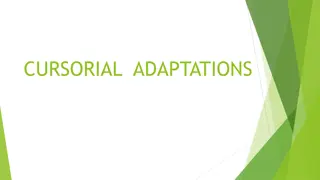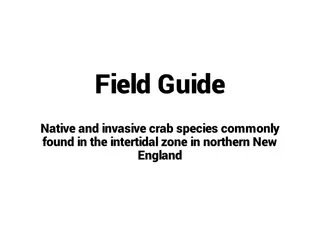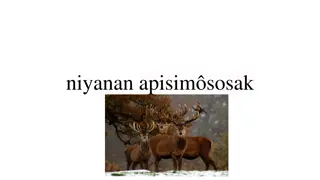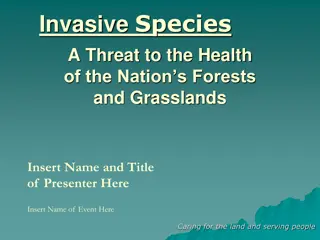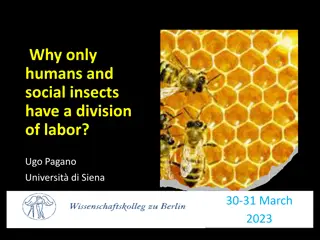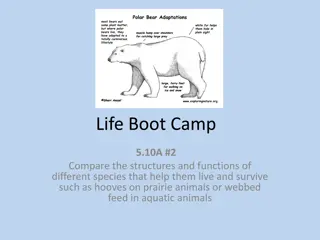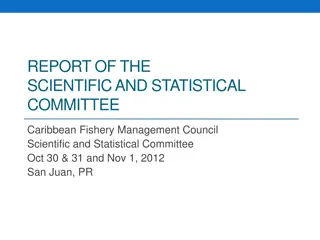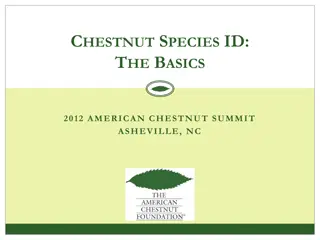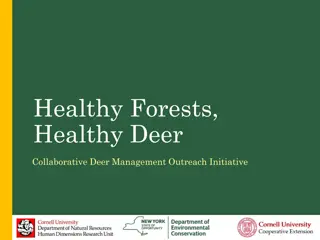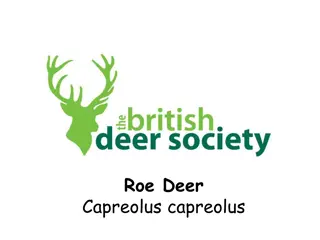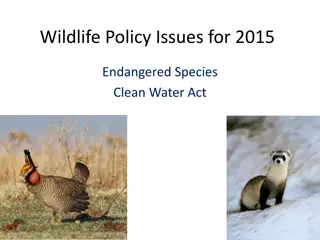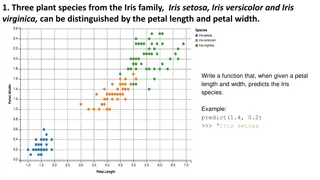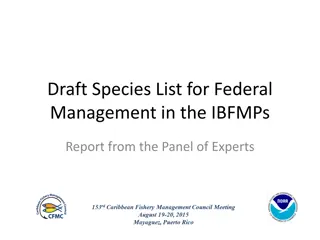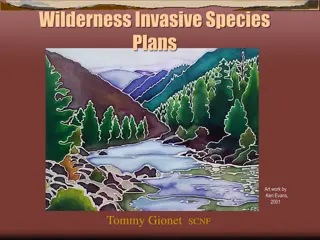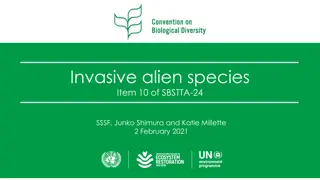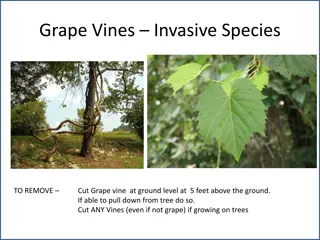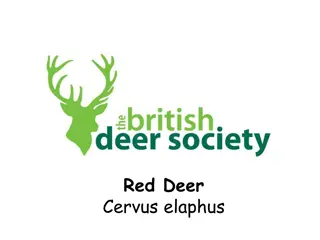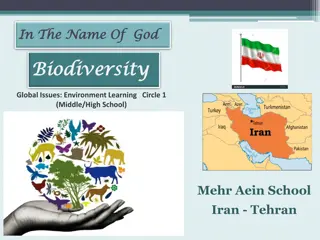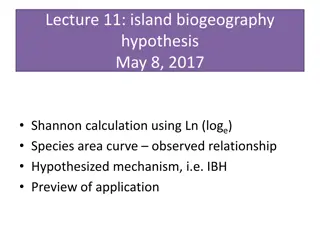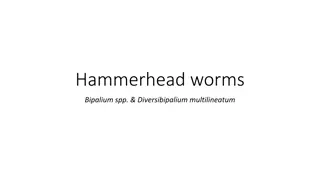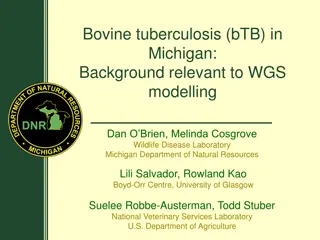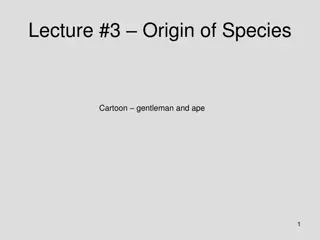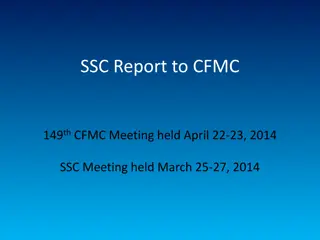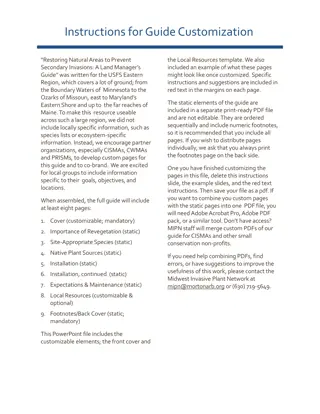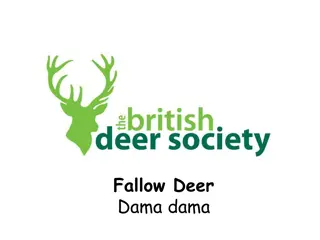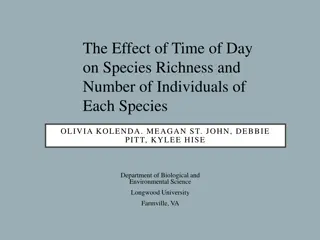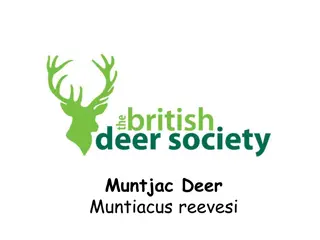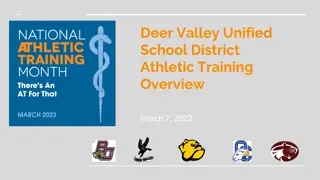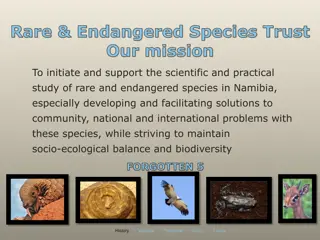Understanding Invasive Species Transmission Pathways
Explore the identification and transmission pathways of priority pests, focusing on the measures like plant pest analysis, survey enhancement, and rapid response capabilities for invasive species management. Delve into the critical role of human interactions in creating pathways for invasive species
2 views • 17 slides
Addressing Deer Overpopulation Through Urban Archery Program in Hillsborough
Residents in Hillsborough proposed an Urban Archery program to tackle deer overpopulation, supported by research and feedback from the NC Wildlife biologist. The program, over 20 years old with successes in other municipalities, allows additional town rules beyond state guidelines. With minimal hunt
1 views • 13 slides
Understanding Invasive Species in Northwest Michigan
Explore the impact of invasive species in Northwest Michigan through images and data on habitat support for butterfly and moth species, the transition of non-native plants to becoming native, and the definition of what makes a species invasive. Learn about the threats posed by non-native species and
4 views • 15 slides
Understanding Cladograms and Phylogenetic Analysis
Cladograms are used in cladistics to illustrate evolutionary relationships between organisms based on shared ancestral and derived characters. They are created by grouping species by common descent, forming clades that include an ancestral species and all its descendants. Valid clades are monophylet
0 views • 11 slides
Understanding Biodiversity and Conservation: Importance and Key Concepts
Biodiversity is the variety of life on Earth, encompassing all species and ecosystems. Conservation efforts are crucial to preserve genetic, species, and ecological diversity. The values of biodiversity range from productive and economic to social and aesthetic. Maintaining a balance in ecosystems,
4 views • 17 slides
Adaptations of Cursorial Animals: Cheetah, Horse, and Musk Deer
Explore the cursorial adaptations of three distinct animals - the cheetah with its incredible speed, the horse designed for swift running, and the musk deer adapted for elusive movements. Learn about their habitats, unique characteristics, and specialized adaptations for survival in their environmen
0 views • 12 slides
Field Guide to Native and Invasive Crab Species in Northern New England Intertidal Zone
This field guide provides detailed information on native and invasive crab species commonly found in the intertidal zone in northern New England. It includes identification features and distinctions among the species, serving as a useful tool for conducting intertidal green crab quadrat surveys. The
0 views • 4 slides
Impacts of Climate Change on Ecosystems and Biodiversity in the United States
Climate change is significantly affecting species, populations, and ecosystems in the United States. Changes include alterations in the characteristics of organisms, shifts in biological event timing, and disruptions in geographic ranges. These impacts can lead to extinctions when species can't adap
0 views • 16 slides
Heartwarming Tale of the Deer and Moose
In this heartwarming story, a deer and a moose encounter each other in the forest. The moose offers comfort and care to the deer, who has lost their mother to a wolf. Together, they find solace in the Great Spirit's love and the strength of their bond. A touching narrative of compassion and support
0 views • 6 slides
Managing Invasive Species to Safeguard our Forests
Invasive species pose a significant threat to the health of our nation's forests and grasslands, causing ecological, biological, and economic losses. This presentation highlights the impact of invasive species and underscores the importance of collaborative efforts to effectively combat this problem
2 views • 14 slides
Evolution of Division of Labor in Humans and Social Insects
Evolutionary advantages of cooperation and specialization led to a developed system of social cooperation and division of labor in humans and social insects. Despite vast differences, these species have conquered the earth due to common characteristics. The puzzle lies in why only a few species evol
0 views • 23 slides
Comparative Structures and Functions in Different Species
Explore how various species' physical adaptations, such as hooves and webs, aid in their survival. Understand the key roles of specific plant parts like stems and sunflower sections. Discover how specialized structures in animals like deer and polar bears contribute to their survival strategies.
0 views • 101 slides
Caribbean Fishery Management Council Scientific and Statistical Committee Report 2012
The Scientific and Statistical Committee (SSC) of the Caribbean Fishery Management Council reviewed species units with Annual Catch Limits (ACL) overages and discussed research priorities. When ACLs are exceeded, accountability measures are triggered, leading to a reduction in the fishing season. Th
1 views • 26 slides
Various Species of Honey Bees in Apiculture
There are over 20,000 species of wild bees, with honey bees being important for commercial apiculture. Four significant species reared are Apis dorsata (Rock bee), Apis florea (Little bee), Apis indica (Indian bee), and Apis mellifera (European bee). Each species has unique characteristics and yield
0 views • 10 slides
Fascinating Facts About Fallow Deer
Fallow deer, introduced by the Normans for hunting, boast flat antlers shed annually. Living in herds, they mate in autumn, giving birth to agile fawns in seven months. Their diet includes various plants, and they leave distinctive tracks in the wild.
0 views • 15 slides
The Impact of Invasive Species on Biodiversity and Ecosystems
The introduction of foreign species can have detrimental effects on biodiversity, ecosystems, and even humans. Invasive species like the Sea Lamprey and Burmese Python disrupt natural habitats, leading to a decline in biodiversity and posing risks to native species and human populations. However, th
0 views • 13 slides
Overview of Chestnut Species: American, European, Chinese, and Japanese Chestnuts
Important information about various chestnut species including American chestnut, European chestnut, Chinese chestnut, and Japanese chestnut is provided here. Details such as characteristics of leaves, twigs, buds, and growth patterns for each species are covered. Hybrid chestnuts and breeding effor
0 views • 16 slides
Understanding Deer Impact on Forest Regeneration
Explore the collaborative deer management outreach initiative focused on maintaining healthy forests by addressing the impact of white-tailed deer on forest regeneration. Learn about the factors influencing forest health, predicted regeneration of tree species, and survey results on forest regenerat
0 views • 27 slides
Discovering the Fascinating Roe Deer: All About Their Appearance and Behavior
Roe deer, native to Britain, have distinctive features such as large ears with black rims, two white spots on their nose, and small antlers with three points on each side. While male roe deer, called bucks, grow antlers that fall off yearly, females, known as does, do not possess antlers. Observing
0 views • 20 slides
Wildlife Policy Issues for 2015: Endangered Species & Clean Water Act
Overview of policy issues surrounding endangered species and clean water act in 2015, including definitions, history, causes of endangerment, petition and listing factors. Focus on protecting species like the Lesser Prairie Chicken and Black-footed Ferret. Mention of Kansas' threatened and endangere
0 views • 21 slides
Helpful Functions for Iris Species Prediction and Dot Number Calculation
The provided content includes a function to predict Iris species based on petal length and width (Iris setosa, Iris versicolor, Iris virginica) and a function to calculate the number of dots in a figure pattern. The Iris prediction function uses specific criteria for each species, and the dot number
1 views • 6 slides
Draft Species List for Federal Management in IBFMPs Report
Panel of Experts was tasked with developing a draft list of species for federal management in Island-Based Fishery Management Plans (IBFMPs). Approaches outlined for selecting species include considering factors like species occurrence in State waters, stock status, ecological importance, and econom
0 views • 27 slides
Understanding the Impact of Invasive Species in Wilderness Management
Invasive species pose a significant threat to the ecosystem by causing disruptions in biodiversity and ecosystem health. This article discusses the importance of managing invasive species in wilderness areas and provides insights into creating successful Invasive Species Plans. It sheds light on the
0 views • 22 slides
Global Efforts in Managing Invasive Alien Species
Status reports on invasive alien species worldwide, including findings on successful eradications, regulations in various countries, and outcomes of online forums discussing technical guidance for managing invasive species under the CBD. Efforts include the development of tools, guidance, regulation
0 views • 10 slides
Invasive Plant Species Removal Guide
Learn how to effectively remove invasive plant species such as grape vines, garlic mustard, Japanese barberry, honeysuckle, and multiflora rose with detailed instructions and images for each species. Take necessary steps to remove these invasive species to protect native plant biodiversity.
0 views • 5 slides
Fascinating Insight into Red Deer: Learn About the Largest Deer in Britain
Explore the world of Red Deer, the largest deer species in Great Britain, known for their majestic presence and impressive antlers. Discover their physical characteristics, behaviors, and habitat preferences, including their iconic roars during autumn. Learn about Stags, Hinds, and Calves, as well a
0 views • 19 slides
The Significance of Biodiversity in Ecosystems
Biodiversity plays a crucial role in boosting ecosystem productivity by ensuring each species contributes uniquely. Measuring biodiversity involves counting species in an area, with a higher species diversity indicating greater biodiversity. Despite this importance, an alarming number of species go
0 views • 17 slides
Island Biogeography Hypothesis and Species-Area Curves Overview
Explore the Island Biogeography Hypothesis through Shannon calculations and Species-Area Curve observed relationships. Learn about the mechanisms of island biodiversity, generalizations of species richness, and equilibrium concepts. Discover how area size influences species diversity and the impact
0 views • 24 slides
Hammerhead Worms: Invasive Species Identification and Overview
Invasive terrestrial flatworms known as Hammerhead Worms, including species like Bipalium spp. and Diversibipalium multilineatum, have been introduced to various regions, likely through soil or potted plants. Five invasive species have been identified, each with distinct characteristics and sizes. W
0 views • 9 slides
Bovine Tuberculosis (bTB) in Michigan: Insights and Findings
Background information on the prevalence and zoonotic cases of bovine tuberculosis in Michigan, USA, highlighting statistics on infected livestock herds and wild deer over the years. The extent of zoonotic bTB cases and the achievable elimination of bTB from cattle are discussed, along with accredit
0 views • 24 slides
Understanding Species Concepts in Evolutionary Biology
Explore the various species concepts in evolutionary biology, including biological and morphological definitions, critical thinking on species boundaries, and the challenges of defining species based on reproductive isolation and morphological differences. Dive into key concepts like speciation, hum
0 views • 75 slides
Criteria for Species Inclusion in Fishery Management Plans
The report outlines criteria for species inclusion in island-based fishery management plans, covering national standards, stock management, and minimizing costs. It discusses key factors such as target stocks, ecosystem components, and economic importance. The suggested draft criteria include biolog
0 views • 17 slides
High School Registration and Graduation Information in Deer Valley Unified School District
Registration information for future freshmen in Deer Valley Unified School District high schools including course requirements, graduation criteria, and elective options. Details on essential subjects, credit distribution, graduation credits, and recommended courses. Guidance for freshman schedules
0 views • 17 slides
Northwest Michigan Invasive Species Network Overview
The Northwest Michigan Invasive Species Network (ISN) is a Cooperative Invasive Species Management Area dedicated to managing invasive species in northwest Michigan's natural areas. Founded in 2005 and funded through grants and private donations, ISN collaborates with over 60 partners to address inv
0 views • 5 slides
All About Fallow Deer - Unique Characteristics and Behaviors
Fallow deer, native to the British Isles, are known for their spotted coat, impressive antlers, and distinct appearance. Learn about their habitats, behaviors, and physical features in this informative content, complete with captivating images. Discover interesting facts like the shedding and regrow
0 views • 19 slides
Effect of Time of Day on Bird Species Richness and Individuals
The study investigates how the time of day impacts the species richness and number of individuals of birds at a specific feeder in Longwood University's Environmental Education Center. Through observational studies and counting, the researchers aim to determine if there are differences in bird popul
0 views • 20 slides
Discover the Fascinating Muntjac Deer - A Unique Species in the British Isles
Learn about the Muntjac deer, a small and adaptable species rapidly spreading across Great Britain. Introduced from China to Woburn Park, they have unique features like scent glands and hunched appearance. Find out about their habitat, physical characteristics, and more.
0 views • 17 slides
Athletic Training Overview in Deer Valley Unified School District
This overview provides insights into the athletic training program in Deer Valley Unified School District. It includes details about the athletic trainers, their combined experience, educational requirements, domains of athletic training, and daily duties involved in providing medical services, inju
0 views • 13 slides
Deer Valley Annual General Meeting Highlights
The Deer Valley Annual General Meeting took place on November 17, 2021, featuring updates on various community activities such as playground landscaping, animal ownership bylaws, architectural controls, re-zoning initiatives, utility board updates, and park improvements. The meeting emphasized the i
0 views • 12 slides
Rare & Endangered Species Trust: Protecting Namibia's Vultures and Pangolins
Rare & Endangered Species Trust in Namibia focuses on studying and supporting rare and endangered species, particularly vultures and pangolins. With a mission to find solutions to conservation challenges and maintain biodiversity, the trust highlights the history, crisis, and future prospects for th
0 views • 19 slides





